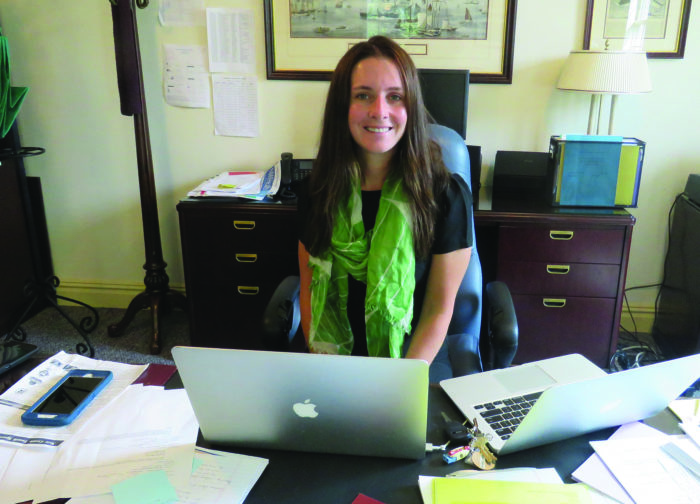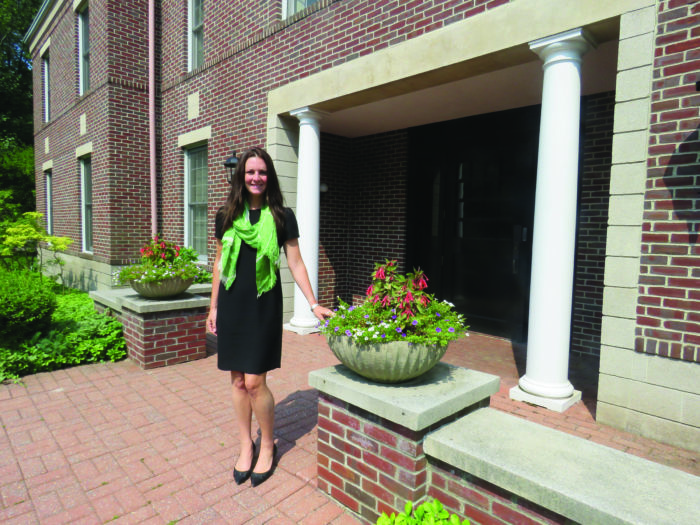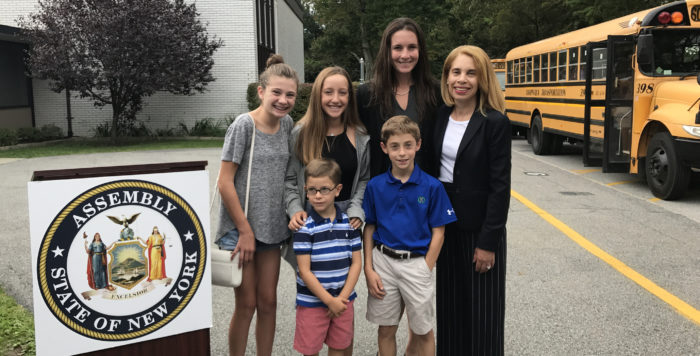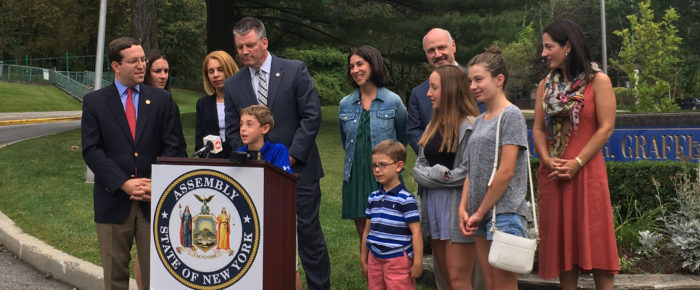An Avid Runner, the CCSD’s New Superintendent also Goes the Extra Mile to Emphasize Communication, Transparency and Supporting District Wide Initiatives in STEM, Health – and Social Justice, too.

BY GRACE BENNETT
Maybe I’m just getting older, but upon meeting new Chappaqua school district Superintendent Christine Ackerman this past summer, I could not help but marvel at how youthful she seemed; I was certain she was young enough to be my daughter. Ok, well almost! And so I asked her how her youth might lend a reinvigoration of sorts and fresh perspective to our schools while taking on 21st century challenges.
First, some background: Ackerman, only 39 years old, comes to Chappaqua after three years as Superintendent of the Greenwood Lake Union Free School District, following four years as Assistant Superintendent for Curriculum, Instruction and Pupil Personnel Services with the Millbrook Central School District, where she had served as its high school principal for a year and a half. Prior to that, she was Assistant Principal & Director of Social Services at Valhalla Middle/High School, Dean of Students at John Jay High School in Katonah, and a teacher and Dean of Students in the New York City school system.
A native of Vernon, New Jersey and one of four children, she credits her decision to take an unorthodox route for an educator – going directly from college to graduate school to receiving her PhD – as the reason that doors opened very quickly and enable her to compile such an impressive and varied resume for someone so young.
A New and Broader Outlook
“I think I have a fresh perspective. I’ve had a lot of different experiences in various roles within a school district,” Ackerman explained when asked what she brings to Chappaqua. “I’ve been a teacher, an assistant principal, a principal, an assistant superintendent for special ed, for curriculum and instruction, and superintendent, so I think I have a large frame of reference, which I am able to use when I’m looking at different issues, whether they’re instructional or social/emotional.” She elaborated that she will be able to draw from her experiences in diverse districts, “from high-performing districts to the inner-city,” enabling her to work with different constituent groups on a wide range of issues.
She also stressed the value of having her own children (a third grader at Westorchard and a fifth grader at Seven Bridges) enrolled in Chappaqua schools. “I can’t underscore the importance of having my own kids here: it’s very, very important,” said Ackerman, a single mom in the district. “I want people to have confidence in the fact that I feel that this is the best place for my kids to receive an education. I think it speaks volumes, it speaks more than anything I could ever say to have my own children to be able to experience what I feel is one of the best educational experiences they could have in the state, if not the country.”
“When you have children that go through the district, it gives a different perspective, not only as an administrator, but as a mom,” Ackerman continued. “You get real time experience when you’re a mom – the homework, the assessments – you have a different lens because you’re not only looking at it in terms of how the structure and the education and social program are operating, but you’re looking at it in terms of how your own child is experiencing it.” She added that “it lends a different credibility” when people know that decisions she makes as an instructional leader will directly impact her own children too.
As an example, Ackerman described transitioning one of her prior district’s anthology reading program to a writing workshop program – what currently exists in Chappaqua – as the literacy instructional base. Not surprisingly, there were many questions, and she was able to “very clearly say it benefits [the children, including my own] and why these are the practices I’ll be doing with my own children at home to support what’s happening in the classroom.”
Ackerman does not sense any real discomfort of her kids or their teachers in her dual position as Superintendent and classroom mom. “I think [my kids] are proud of their mom, and they see me because I’m very present in the buildings with the kids. For them it’s normal to have their mom walking around the building and going in and out of their classes,” she said. She added that in her prior Superintendent position, if “any initial unfamiliarity with me existed, as time went on and the frequency of my interactions with the people increased, I think that any kind of trepidation dissipated. It would be my goal, though, that people would feel comfortable interacting with me as a colleague, not necessarily as a supervisor, because I think that’s where the best collaboration happens for kids.”
Ackerman’s children, like their mom, however, are most excited about the opportunities available to them in Chappaqua. “The facilities and the extracurricular program in Chappaqua is unbelievable; when it’s all you’ve experienced, you don’t really have a broader perspective of what else is out there for kids,” she said, noting the difference in other schools her children have attended. “When we pulled up to Seven Bridges and my son saw where he was going to school, he was amazed, and so was I,” she added.
“All of our facilities are so thoughtful and designed in a way to really support instruction differently. The opportunities here are endless for our kids, and I am just so privileged that my kids are going to be able to have that same opportunity as other students.”

Full STEAM Ahead: Collaboration and Technology
Emphasizing the high level of instruction in our district schools, Ackerman hopes to even further enhance technological and collaborative tools to even better prepare our students for college and beyond.
“I’m extremely passionate about educational technology, because I feel that we need to prepare students to leave here ready to interact and integrate into a society that is focused on web-based interactions,” she said. “And I also feel that, if you look at college and career readiness standards, we exceed many of the academic standards, but one of the things that businesses really focus on is the ability of kids/employees to work collaboratively to solve real-world problems.”
Ackerman has been very impressed with CCSD’s work with collaborative spaces.
“I think one of the smart, visionary decisions that the previous Superintendent had was the concept of these maker-spaces, because they really have kids applying content in real-life application.” She points to the district’s redesign of school spaces to support STEAM work.
“We have our iLab in the high school, and we’re beginning to think differently in our elementary schools by incorporating some of the practices in our high school. We’re looking at spaces differently.” She described a pilot project at Westorchard “where we’re really looking at our classroom design in a way that supports student collaboration.”
Challenges Ahead
As Superintendent, Ackerman is an integral part of the CCSD Board of Education. “It’s a partnership, so every meeting I’m there with them, preparing the agenda, preparing reports for the community, for the Board of Education on our progress and what we’ve been focused on. We have a very dedicated group of individuals from all sorts of constituencies. I feel so fortunate to be able to work for this Board of Education. They’re really focused on the kids.”
Upon arriving in Chappaqua, Ackerman has had numerous “entrance meetings” with different constituent groups, all confirming the CCSD’s strength. “The faculty, staff, and administrative team are extremely strong, very professional, and devoted to our kids in a way that’s probably unique compared to other districts,” she said. “You have some of the top people in their profession working in this district with our students. This is where you want to teach: the professional development, the commitment of the community towards providing the best education for the children here, is unparalleled.”
One of the biggest challenges facing the district that she has been asked to focus on is communication and transparency. “Some of the things that we’re already in the process of engaging in will be re-designing our website, thinking about how we’re structuring our board meetings, talking about what can we share versus what can’t we share, and just being really cognizant of making sure that people feel comfortable with the processes that we have in place,” Ackerman explained.
“We have a lot of committees – including communications – that look at a lot of many different aspects of our program,” she continued. “I look forward to leveraging some of those committees to talk about what I heard in entrance meetings. One of the things that we’ve been talking about in terms of communication is our social media presence – we really don’t have one. Can we have a voice on social media? These are all things that are important but they’re a process and they take time,” she added.
Ackerman thinks that the team in place is up to the challenge, brushing aside the idea that a consultant or public relations firm might be needed. “I just think we need to work with the people that we have and work with our parents to all be comfortable, because I think, in terms of people feeling like they want more communication from the district that can get that feedback from our community and use that to figure out how we’re going to move forward.” Ackerman is on it.
She noted that she has already engaged in some outreach with local publications, this one included. “I think we need to look at that,” she said. “I’ve already made some contact with our local media providers, I’ve tried to build relationships with our newspaper, because I think there’s a lot going on here that we can highlight as well. I feel like it’s an opportunity for us.”
Ackerman also recognizes that there is work to be done as far as instilling strong values in students of an affluent district. She recalled that one of the focus areas of this past summer’s administrative retreat was the social and emotional growth of students, which she described as an integral piece of the academic program and “one of our responsibilities.”
“I know that there’s been a lot of work done in individual buildings around this particular issue with staff members and under the leadership of the administration, so one of the areas that I know we’re going to look at collaboratively as a district K-12 is how we’re all working collectively on that important component of the academic program,” she said.
She also noted the need to help the student body appreciate diversity and build tolerance. “I support social justice [and was] trained by the Social Justice Institute,” Ackerman said. “I find that it has to be embedded in the curriculum and that it’s something that happens on a regular basis in the classrooms through teachers interactions with kids, but I also know there’s value in having teacher-student connections and individual conversations that focus on these issues specifically.” She is working on figuring out how to structure the school day around promoting “common values that we all value as humans and that we need to partner on and complement each other from home to school.”

Nutrition and Fitness
Ackerman, an avid runner (five to seven miles every morning before going to work), is an advocate in fitness and healthy eating, for herself, her children and the students in the district. “I think it’s important for my own kids to see me valuing my health and to be healthy, so I am committed to making sure that our kids [do the same],” she said. She also notes the evidence that supports how nutrition affects school performance; “there’s so much research that supports how students come to school, and what happens in the morning, particularly around what they’re eating in terms of preparing them for instruction, so I think how our kids spend their lunch breaks and what they eat during their lunch breaks are important, absolutely.”
First Impressions
One of Ackerman’s early experiences as the CCSD Superintendent was marching in the town’s Memorial Day Parade and meeting Hillary and Bill Clinton and Governor Andrew Cuomo. “It was amazing for me to be able to be in the presence of the former President and the Secretary of State. They took time with me to find out where I was from, and offered their assistance with any support that I would need. They affirmed to me how great the community was. I was honored,” she said. However, what impressed her even more was that the Board of Education immediately followed these illustrious residents in the parade. “What I found most telling though about that experience, and this really for me put in perspective how much this community values education, was the parade order was the President, Secretary of State, the Governor, and the Chappaqua Board of Education. That was amazing to me.
To see that level of commitment that this community has toward its schools and respect,” Ackerman recalled.
The school year got off to an exciting start, too, with a packed-house September 8 community event celebrating the new Greeley track and field under the newly-installed lights. “This community event was designed to foster a sense of togetherness amongst our K-12 students and community,” she said. “We also wanted to take a moment to truly celebrate our new facility that will be used by all facets of our community.” Indeed, the event was attended even by Chappaqua’s youngest residents and enjoyed by all.
An emotional and inspiring event on that same field followed several weeks later, as the Greeley boys’ varsity soccer team dedicated a home game to one of its own who tragically passed away this summer. “One of my most memorable moments so far was watching the boys’ soccer team honor Casey Taub [who had worn uniform number 22] by leading the crowd in a standing ovation as they played during the 22nd minute of a recent home game,” Ackerman recalled. “The senior captain even scored a goal at 22:22 – it was such a moving tribute to this young man. I continue to be impressed by the quality of instruction and the caliber of students who are members of the Chappaqua Central School District community.”

She is also impressed with the philanthropy and advocacy of student and parent groups. For example, “our students and parents worked together to advocate for legislation that would allow bus drivers who are not employees of the District to administer EpiPens.” She added that “we are currently working to develop a Board of Ed policy in conjunction with Chappaqua Transportation to support our students in this way.”
To that end, Ackerman wanted the community to be aware that the District will be engaging in “a strategic cohesive planning process to identify long and short term goals in relation to the Board of Education’s strategic questions over the course of this school year.” And most importantly, Ackerman stressed that she is available to talk with anyone about any issue.
“I am available and people can feel free to contact me if they need help, if they want to talk to me, they have ideas, I’m open. They can email me at chackerman@ccsd.ws or they could set up a meeting. I’m here, I’m open, and I’m here to be their partner. I’m really looking forward to those experiences with people here.”
Bus Drivers Get Green Light to Administer EpiPens
At her first press conference for the district at Douglas Grafflin Elementary School, Christine Ackerman joined parents and students and Westchester sponsors of a new law passed to protect and save the lives of students who suffer from severe allergies. Assemblyman David Buchwald and State Senator Terrence Murphy co-sponsored the legislation which now allows school bus drivers and others employed by firms providing services to schools to administer epinephrine when a child suffers anaphylaxis shock.
Christine Ackerman: “Our students and parents worked together to advocate for legislation that would allow bus drivers who are not employees of the District to administer EpiPens.”
David Buchwald: “The New York State Department of Health will need to move quickly to issue the regulations necessary for the timely implementation of this act.”
Terrence Murphy: “When a child experiences anaphylaxis, there is little time to wait for emergency personnel to arrive. Every second is crucial.”
Advocate Stacey Saiontz: “Recently, a school bus driver in Massachusetts saved a student’s life when emergency personnel could not arrive on the scene in time. I am so pleased New York school bus drivers will be able to do the same.”
Grace Bennett is Publisher and Editor-in-Chief of Inside Chappaqua Magazine. This interview was edited by long time Inside Press contributor Debra Hand. Special thanks as well to intern Amanda Kraus for transcribing.
